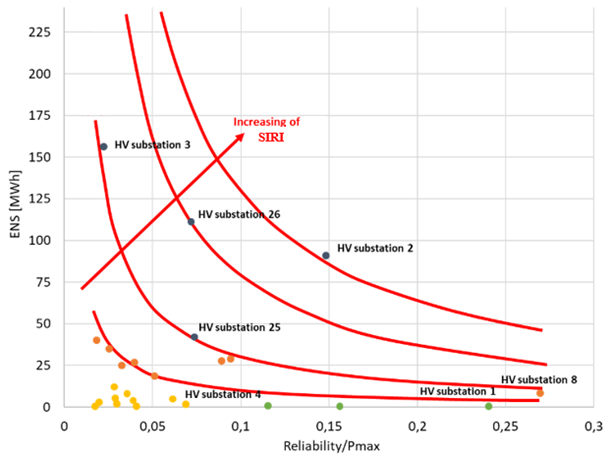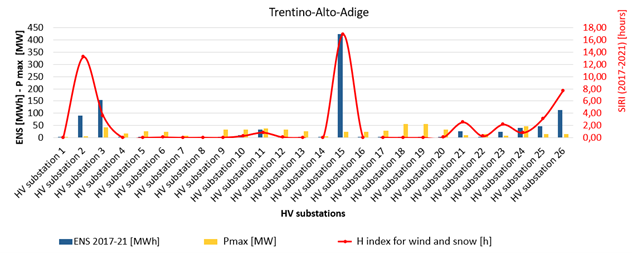Evaluation of grid operational resilience stressed by energy transition and by climate change: new metrics (SIRI) and countermeasures
For the High Voltage (HV) electrical grid, concepts and applications related to resilience have become quite common, even at the planning stage. According to the definition reported by CIGRE WG C4.47, power system resilience is the ability to limit the extent, severity and duration of system degradation following an extreme event and it is achieved through a set of key actionable measures to be taken before, during, and after extreme events.

By
Chiara Vergine, Enrico M. Carlini, Gabriele Biasiotti, Simone Talomo - Terna Rete Italia, Italy
Luigi Calcara, Massimo Pompili - University of Roma “La Sapienza”, Italy
Antonio Iliceto CIGRE- Chairman of SC C1 (Power System Development & Economics)
Each negative event should give additional information useful for improving the system according to the general principle of lessons learned.
Furthermore, when talking about resilience of electrical networks it is also necessary to consider the recent need to even better adapt and reinforce the grid to take into account the ongoing energy transition and climate change. In fact, our global population is rapidly expanding, and current energy models are no longer sustainable. Simultaneously, there is a global call for a unified commitment to accelerate the decarbonization process. In addition, extreme weather events are increasing rapidly worldwide: system operators such as TSOs must be able to adapt quickly to this framework, identifying methods and operational strategies that can cope with such threats when their intensity exceeds the limit of infrastructural resilience.
With the aim of evaluating the ability to face the effects of extreme events or critical issues that could arise in the climate change and energy transition context, an innovative metric for operational resilience evaluation is proposed.
Climate change and energy transition
An efficient HV transmission system is crucial for accompanying green energy transition considering the larger use of Renewable Energy Sources (RES), cost reduction principles, sustainability, and resilience. This process is moving on in a general contest of climate changes which already are worrying the European citizens and electrical system operators. In 2023, extreme weather led to severe socio-economic impacts. It was the warmest year on record at 1.45 ± 0.12 °C above the pre-industrial average, and extreme heat affected many parts of the world. Wildfires in Hawaii, Canada, and Europe led to loss of life, the destruction of homes, and large-scale air pollution. Flooding associated with extreme rainfall from Mediterranean Cyclone Daniel affected Greece, Bulgaria, Türkiye, and Libya with particularly heavy loss of life in Libya [4].
Over the last 20 years the temperature in Europe has increased significantly and with it the number of droughts and heatwaves. In addition, storms, floods, and snowfall are more intense than in the past (examples in Fig.1).

Figure 1 -Vaia WindStorm (2018) and SnowStorm (2019) in Alpine Italian region (Trentino Alto-Adige)
These new climatic conditions (extreme weather events) pose an increasing danger to HV electrical systems and substations.
To measure power system resilience with respect to these events, both qualitative and quantitative metrics are often used. Normally, quantitative indicators are based on single event curves giving an estimation of the extent of the damage to the system before the recovery. These curves assume shapes normally known as resilience triangles or trapezoids. The integrals of the energy not supplied are strictly correlated with the power system resilience. In this framework, indicators as degree and duration of degradation, rate of restoration, and overall performance are normally used.
During extreme negative events, a major importance is given to operational resilience, which refers to the ability of an organization to maintain its core functions and continue to provide its critical services during and after a disruptive event. It includes information flows and technologies, recovery actions, processes, people, and supply chains. It aims to minimize the impact of disruptions and ensure that the organization can recover quickly.
An innovative metric for operational resilience evaluation, named H or SIRI (SIte Resilience Index), is based on a function that considers data of Energy Not Supplied (ENS), maximum Power (Pmax), and infrastructural reliability of different HV substations. The main advantages of this innovative index are:
- to consider both of the magnitude of the event and the characteristics of the affected portion of the grid in terms of reliability and power consumption;
- to allow the evaluation of operational resilience for each HV substation (point of delivery), making possible comparisons;
- to allow the evaluation of the impact of an outage of a part of the electrical grid, both at regional and/or at national level, making comparisons possible and evaluations of more urgent improvements (both infrastructural and related to operational resilience).
SIte Resilient Index (SIRI)
Starting from the data of Energy Not Supplied (ENS), maximum Power (Pmax) and infrastructural reliability of one HV electrical substation/system it is possible to define a new resilience index able to measure the overall ability to withstand negative events. This index may be evaluated for each HV site, as in the following:
in which the Reliability indicates the probability that the negative events will not occur in a given time period and is the complementary of the failure rate of a component or system.
The index SIRI is then given by the product of two terms, namely ENS and Reliability/Pmax which identify a family of hyperbolae on the plan Reliability/Pmax and ENS. By plotting these hyperbolae on a graph, it is possible to envisage the relationship between ENS and the maximum power which may be supplied by a given HV system/substation. The more critical HV systems/substations are represented in the upper hyperbolae and the criticality decreases moving down along the other curves. On the left side of the plan are the sites deserving more attention since they are characterized by high values of the power and low values of infrastructural resilience and therefore for these sites grid reinforcement should be prioritized.
This situation is depicted in Figure 2 representing all the HV substations located in one Italian Region (Trentino-Alto-Adige). The index SIRI has been evaluated for all the outages related to snow/ice and storms registered in the period 2017-2021.
The same situation is represented in Figure 3 which displays the relationship existing between the relevant outages (in terms of ENS) and each HV substation.

Figure 2 - Family of hyperbolises on the plan Reliability/Pmax and ENS to identify the SIte Resilient Index (SIRI) for different HV substations in Trentino-Alto-Adige region (events of 2017-2021)

Figure 3 - Relationship between the relevant outages (in terms of ENS) and each HV substations located in Trentino-Alto-Adige (events of 2017-2021)
Conclusions and C1 work on resilience issues
The resilience of high voltage electrical grids is a critical issue in ensuring the security of energy supply, particularly in the face of extreme weather events caused by climate change. As the electrical system is subject to constant changes in demand, generation capacity, and operational conditions, it is important to develop metrics that accurately capture the system's ability to adapt to changing conditions.
In this paper a new operational resilience index is developed and presented to help TSOs evaluate the actions needed to increase the resilience of the electrical system. By monitoring and analysing these quantitative metrics, it is possible to identify areas where improvements can be made to enhance reliability and reduce the risk of power outages. In the final analysis, the implementation of measures to increase the resilience of electrical grids will be essential in ensuring the security of energy supply and the well-being of society, also in view of the ongoing energy transition.
SC C1 ( Power System Developments and Economics), is deeply involved in Resilience issues, often jointly with other SCs; currently WG C1.47, joint with C4, addresses the internalisation of resilience analysis already into the planning stage of grid developments and components design. The two SCs will hold a physical workshop in Paris session on Resilience issues.
One of C1 Preferential Subjects for Paris 2024 General Session is on Resilience, and has attracted 14 papers.
References
- CIGRE C2 Technical Brochure 833, “Operational strategies and preparedness for system operational resilience", 2021
- L. Campisano, P. Ferretti, S. Neri, C. Quaciari, M. Pierno, E. M. Carlini, “Tools and strategies for managing critical grid situations and extreme weather events”, IEEE, 2020 AEIT International Annual Conference
- Ch. Vergine, E.M. Carlini, G. Biasiotti, S. Talomo, L. Calcara, M. Pompili, “An innovative metric for evaluating operational resilience of the high-voltage grid”, 4th CIGRE SEERC Conference, Istanbul, 2023
- State of the Global Climate 2023, https://wmo.int/
Thumbnail credit: NOAA on Unsplash
